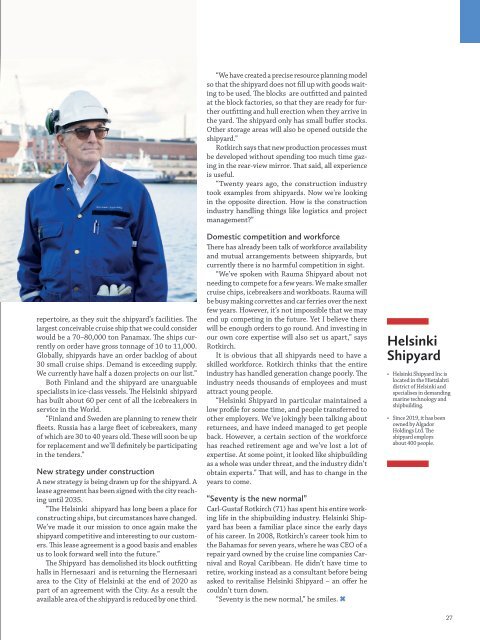Create successful ePaper yourself
Turn your PDF publications into a flip-book with our unique Google optimized e-Paper software.
epertoire, as they suit the shipyard’s facilities. The<br />
largest conceivable cruise ship that we could consider<br />
would be a 70–80,000 ton Panamax. The ships currently<br />
on order have gross tonnage of 10 to 11,000.<br />
Globally, shipyards have an order backlog of about<br />
30 small cruise ships. Demand is exceeding supply.<br />
We currently have half a dozen projects on our list.”<br />
Both Finland and the shipyard are unarguable<br />
specialists in ice-class vessels. The Helsinki shipyard<br />
has built about 60 per cent of all the icebreakers in<br />
service in the World.<br />
“Finland and Sweden are planning to renew their<br />
fleets. Russia has a large fleet of icebreakers, many<br />
of which are 30 to 40 years old. These will soon be up<br />
for replacement and we’ll definitely be participating<br />
in the tenders.”<br />
New strategy under construction<br />
A new strategy is being drawn up for the shipyard. A<br />
lease agreement has been signed with the city reaching<br />
until 2035.<br />
“The Helsinki shipyard has long been a place for<br />
constructing ships, but circumstances have changed.<br />
We’ve made it our mission to once again make the<br />
shipyard competitive and interesting to our customers.<br />
This lease agreement is a good basis and enables<br />
us to look forward well into the future.”<br />
The Shipyard has demolished its block outfitting<br />
halls in Hernesaari and is returning the Hernesaari<br />
area to the City of Helsinki at the end of <strong>2020</strong> as<br />
part of an agreement with the City. As a result the<br />
available area of the shipyard is reduced by one third.<br />
“We have created a precise resource planning model<br />
so that the shipyard does not fill up with goods waiting<br />
to be used. The blocks are outfitted and painted<br />
at the block factories, so that they are ready for further<br />
outfitting and hull erection when they arrive in<br />
the yard. The shipyard only has small buffer stocks.<br />
Other storage areas will also be opened outside the<br />
shipyard.”<br />
Rotkirch says that new production processes must<br />
be developed without spending too much time gazing<br />
in the rear-view mirror. That said, all experience<br />
is useful.<br />
“Twenty years ago, the construction industry<br />
took examples from shipyards. Now we're looking<br />
in the opposite direction. How is the construction<br />
industry handling things like logistics and project<br />
management?”<br />
Domestic competition and workforce<br />
There has already been talk of workforce availability<br />
and mutual arrangements between shipyards, but<br />
currently there is no harmful competition in sight.<br />
“We’ve spoken with Rauma Shipyard about not<br />
needing to compete for a few years. We make smaller<br />
cruise chips, icebreakers and workboats. Rauma will<br />
be busy making corvettes and car ferries over the next<br />
few years. However, it’s not impossible that we may<br />
end up competing in the future. Yet I believe there<br />
will be enough orders to go round. And investing in<br />
our own core expertise will also set us apart,” says<br />
Rotkirch.<br />
It is obvious that all shipyards need to have a<br />
skilled workforce. Rotkirch thinks that the entire<br />
industry has handled generation change poorly. The<br />
industry needs thousands of employees and must<br />
attract young people.<br />
“Helsinki Shipyard in particular maintained a<br />
low profile for some time, and people transferred to<br />
other employers. We’ve jokingly been talking about<br />
returnees, and have indeed managed to get people<br />
back. However, a certain section of the workforce<br />
has reached retirement age and we’ve lost a lot of<br />
expertise. At some point, it looked like shipbuilding<br />
as a whole was under threat, and the industry didn’t<br />
obtain experts.” That will, and has to change in the<br />
years to come.<br />
“Seventy is the new normal”<br />
Carl-Gustaf Rotkirch (71) has spent his entire working<br />
life in the shipbuilding industry. Helsinki Shipyard<br />
has been a familiar place since the early days<br />
of his career. In 2008, Rotkirch’s career took him to<br />
the Bahamas for seven years, where he was CEO of a<br />
repair yard owned by the cruise line companies Carnival<br />
and Royal Caribbean. He didn’t have time to<br />
retire, working instead as a consultant before being<br />
asked to revitalise Helsinki Shipyard – an offer he<br />
couldn’t turn down.<br />
“Seventy is the new normal,” he smiles. ✖<br />
Helsinki<br />
Shipyard<br />
• Helsinki Shipyard Inc is<br />
located in the Hietalahti<br />
district of Helsinki and<br />
specialises in demanding<br />
marine technology and<br />
shipbuilding.<br />
• Since 2019, it has been<br />
owned by Algador<br />
Holdings Ltd. The<br />
shipyard employs<br />
about 400 people.<br />
27

















